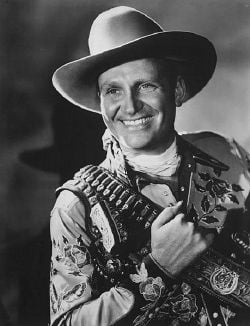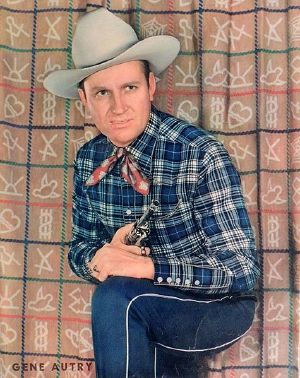Gene Autry
| Gene Autry | |
 Autry in the 1940s
| |
| Born | Orvon Grover Autry September 29 1907 Tioga, Texas, U.S. |
|---|---|
| Died | October 2 1998 (aged 91) Los Angeles, California, U.S. |
| Other names | The Singing Cowboy, Gene Michaels |
| Occupation | Singer, songwriter, actor, musician, rodeo performer, baseball owner |
| Years active | 1925â1964 |
| Spouse(s) | Ina Mae Spivey (m. 1932; died 1980)â Jacqueline Ellam (m. 1981) |
| Relatives | Randy Quaid Dennis Quaid (first cousins twice removed) |
| Website geneautry.com | |
Orvon 'Gene' Autry (September 29, 1907 â October 2, 1998) was an American cowboy singer and actor who gained fame as the first "Singing Cowboy" on the radio, in movies and on television. He had many hit records, including his signature song, âBack in the Saddle Again,â and his biggest hit âRudolph the Red-Nosed Reindeer,â which is still a favorite holiday record today. He starred in scores of western films, and also played the lead in a popular television series.
After retiring, Autry had a successful career as a businessman and baseball owner, appearing many times on the Forbes magazine list of the four hundred richest men in America. He also founded the Museum of the American West in Los Angeles.
Autry was married for 48 years to Ina May Spivey, who died in 1980. He married his second wife, Jackie, in 1981. He had no children by either marriage.
To date, Autry is the only person to have five "stars" on the Hollywood Blvd. "Walk of Fame," one for every possible entertainment category.
Early years
Autry, the grandson of a Methodist preacher, was born near Tioga, Texas. His parents, Delbert Autry and Elnora Ozmont, moved to Ravia, Oklahoma in the 1920s. After leaving high school in 1925, Autry worked as a telegrapher for the St. LouisâSan Francisco Railway.
An amateur talent with the guitar and voice led to his performing at local dances. After an encouraging chance encounter with the famed "cowboy philosopher" Will Rogers, he began performing on local radio in 1928 as "Oklahoma's Yodeling Cowboy."
Singing career
Autry signed a recording deal with Columbia Records in 1931.
In his early recording days, Autry covered various genres, including a labor song, âThe Death of Mother Jonesâ in 1931. His first hit was in 1932 with âThat Silver-Haired Daddy of Mine,â a duet with fellow railroad man, Jimmy Long. Autry also sang the classic hit âI'm Back in the Saddle Again.â Autry recorded numerous Christmas carols, including "Santa Claus Is Coming To Town" andâprobably his biggest hit everââRudolph the Red-Nosed Reindeer,â which carried over from its Christmas-season debut to become the first number-one hit of the 1950s.
Recording and Film Career
Radio
Autry worked in Chicago, Illinois on the WLS radio show National Barn Dance for four years with his own show where he met singer/songwriter Smiley Burnette. Their partnership would last decades and extend from musical collaboration into a lucrative film career.
As he gained popularity among the young generation, Autry created the "Cowboy Code" (also known as the "Cowboy Commandments") in response to his young radio listeners aspiring to imitate him:
- The cowboy must never shoot first, hit a smaller man, or take unfair advantage.
- He must never go back on his word, or a trust confided in him.
- He must always tell the truth.
- He must be gentle with children, the elderly, and animals.
- He must not advocate or possess racially or religiously intolerant ideas.
- He must help people in distress.
- He must be a good worker.
- He must keep himself clean in thought, speech, action, and personal habits.
- He must respect women, parents, and his nation's laws.
- The cowboy is a patriot.
In films
Discovered by film producer Nat Levine in 1934, he and Burnette made their film debut for Mascot Pictures Corp. in In Old Santa Fe as part of a singing cowboy quartet. In 1935, Autry was given the starring role by Levine in the 12-part serial The Phantom Empire. Shortly thereafter, Mascot was absorbed by the formation of Republic Pictures. Autry would make an additional 44 films, all B westerns in which he played the character "Gene Autry," rode his horse Champion, used Burnette as his regular sidekick, and had several opportunities to sing in each film. He had become the top Western star at the box-office by 1937, reaching his national peak of popularity from 1940 to 1942.
Autry was the first of the great singing cowboys, succeeded as the top star by Roy Rogers when Autry served as a flier with the Air Transport Command during World War II. From 1940 to 1956, Autry also had a weekly radio show on CBS, Gene Autry's Melody Ranch. He also launched the Gene Autry Flying "A" Ranch Rodeo show, which debuted in 1940.
Autry briefly returned to Republic after the war to finish out his contract, which had been suspended for the duration of his military service. Thereafter, he formed his own production company to make westerns, which were distributed by Columbia Pictures, beginning in 1947. He also starred and produced his own television show on CBS beginning in 1950.
Autry retired from show business in 1964, having made almost a hundred films by 1955 and over six hundred records. Post-retirement, he invested widely in real estate, radio and television, including buying the copyrights from moribund Republic Pictures for the films he had made for them. He also became a well-know baseball team owner.
Baseball executive
In 1960, when Major League Baseball announced plans to add an expansion team in Los Angeles, Autryâwho had once declined an opportunity to play in the minor leaguesâexpressed an interest in acquiring the radio broadcast rights to the team's games. Baseball executives were so impressed by his approach that he was persuaded to become the owner of the franchise rather than simply its broadcast partner.
The team, debuting in 1961, was the Los Angeles Angels, a name previously used by a popular Pacific Coast League team. The team had a number of name changes after moving to suburban Anaheim in 1966, where they became known as the California Angels. The team was called the Anaheim Angels from 1997 until 2005, when they became known as the Los Angeles Angels of Anaheim.
Gene Autry served as vice president of the American League from 1983 until his death. In 1995 he sold a quarter share of the team to The Walt Disney Company, and a controlling interest the following year, with the remaining share to be transferred after his death. Earlier, in 1982, he sold Los Angeles television station KTLA for $245 million. In 1964, KTLA was purchased by Autry and merged with his other radio properties (including Los Angeles' KMPC) into an umbrella company, Golden West Broadcasters. KTLA was sold to an investment firm and then became a leading independent television station.
Death
Gene Autry died of lymphoma on October 2, 1998 at age 91 at his home in Studio City, California. He is interred in the Forest Lawn Memorial Park in Los Angeles.
Legacy
- Autry was elected to the Country Music Hall of Fame in 1969 and to the Nashville Songwriters Hall of Fame in 1970.
- In 1972, he was inducted into the Western Performers Hall of Fame at the National Cowboy & Western Heritage Museum in Oklahoma City, Oklahoma.
- His autobiography was published in 1976, co-written by Mickey Herskowitz; it was titled Back in the Saddle Again after his 1939 hit and signature tune.
- Autry's voice is featured every year on radio and shopping mall theme music at the holiday season, through his timeless recording of âRudolph, the Red-Nosed Reindeer.â
- In 2003, Country Music Television ranked him #38 in CMT's 40 Greatest Men of Country.
- When the Anaheim Angels won their first World Series in 2002, the championship was dedicated in part to him.
- The Museum of the American West in Los Angeles' Griffith Park was founded in 1988 as the "Gene Autry Western Heritage Museum," featuring much of Autry's impressive collection of Western art and memorabilia. It has become a respected institution, preserving the essence of everything related to the "mythic aspects" of the American old westâeverything from true historical lifestyles, to the 70-year history of the Hollywood western movie genre.
- The interchange of Interstate 5 and California State Route 134, located near the Gene Autry Museum of Western Heritage, is signed as the "Gene Autry Memorial Interchange."
Autry was inducted into the Radio Hall of Fame in 2003.
He is also the only person to date to receive five stars on the Hollywood Walk of Fame, for contributions in all five possible categories:
- motion picture starâlocated on 6644 Hollywood Blvd.
- radio starâlocated on 6520 Hollywood Blvd.
- recording starâlocated on 6384 Hollywood Blvd.
- TV starâlocated on 6667 Hollywood Blvd.
- live theater starâlocated on 7000 Hollywood Blvd.
In 2004, the Starz Entertainment Corporation joined forces with the Autry estate to restore all of his films, which have been shown on Starz's Encore Western Channel on cable television on a regular basis ever since.
Popular songs recorded by Gene Autry
- A Face I See at Evening
- That Silver-Haired Daddy of Mine
- The Last Roundup
- Cowboy's Heaven
- Tumbling Tumbleweeds
- Mexicali Rose
- Take Me Back to My Boots and Saddle
- Gold Mine in the Sky
- South of the Border (Down Mexico Way)
- Back in the Saddle Again (1939)
- Be Honest With Me
- Here Comes Santa Claus (1947)
- Rudolph the Red-Nosed Reindeer (1949)
- Peter Cottontail (1950)
- Frosty the Snow Man (1950)
ReferencesISBN links support NWE through referral fees
- George-Warren, Holly. Public Cowboy No. 1: The Life and Times of Gene Autry. Oxford University Press, 2007. ISBN 0195177460
- Green, Douglas. Singing Cowboys. Gibbs Smith, Publisher, 2006. ISBN 978-1586858087
- O'Neal, Bill. Reel Cowboys: Western Movie Stars Who Thrilled Young Fans and Helped Them Grow Up Decent and Strong. Eakin Press, 2000. ISBN 978-1571683304
- Stansfield, Peter. Horse Opera: The Strange History of the 1930s Singing Cowboy. University of Illinois Press, 2002. ISBN 978-0252070495
External links
All links retrieved April 18, 2024.
Credits
New World Encyclopedia writers and editors rewrote and completed the Wikipedia article in accordance with New World Encyclopedia standards. This article abides by terms of the Creative Commons CC-by-sa 3.0 License (CC-by-sa), which may be used and disseminated with proper attribution. Credit is due under the terms of this license that can reference both the New World Encyclopedia contributors and the selfless volunteer contributors of the Wikimedia Foundation. To cite this article click here for a list of acceptable citing formats.The history of earlier contributions by wikipedians is accessible to researchers here:
The history of this article since it was imported to New World Encyclopedia:
Note: Some restrictions may apply to use of individual images which are separately licensed.



